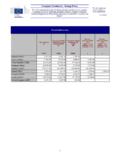Transcription of Evaluation of Innovation Activities - European Commission
1 June 2012 Evaluation of Innovation ActivitiesGuidance on methods and practicesEvaluation of Innovation ActivitiesGuidance on methods and practicesRegional PolicyEuropean Commission , Directorate-General for Regional PolicyEvaluation Unit C4 Marielle Rich Avenue de tervuren 41, B - 1040 #1 Please cite this study as TECHNOPOLIS GROUP & MIOIR (2012): Evaluation of Innovation Activities . Guid-ance on methods and practices. Study funded by the European Commission , Directorate for Regional views expressed in the publication are those of the authors and do not necessarily reflect those of the European Commission . Cover page pictures: Marika Sandell European Union, 2012 Reproduction is authorised provided the source is acknowledgedEvaluation of Innovation ActivitiesGuidance on methods and practicesJune 2012 Table of Contents1.
2 Evaluation methods and Innovation policy Why a guide on evaluating Innovation policy measures? Managing an Evaluation : main steps and methods How to use this guide 122. Evaluating science-industry co-operation What sorts of Innovation Activities are supported? What is the expected result of such measures? Managing an Evaluation of a science-industry co-operation measure Which specific methods are most relevant? Summary practical tips 193. Evaluating strategic research and technology measures What sorts of Innovation Activities are supported? What is the expected result of such measures? Managing an Evaluation of a strategic research programme Which specific methods are most relevant?
3 Summary practical tips 284. Evaluating support services to innovating firms: the example of science parks What sorts of Innovation Activities are supported? What is the expected result of such measures? Managing a science park Evaluation Which specific methods are most relevant? Summary practical tips 365. Evaluation of Innovation funding for companies What sorts of Innovation Activities are supported? What is the expected result of such measures? Managing an Evaluation of business Innovation support Which specific methods are most relevant? Summary practical tips 446. Evaluating clusters policy What sorts of Innovation Activities are supported?
4 What is the expected result of such measures? Managing a cluster measure Evaluation Which specific methods are most relevant? Summary practical tips 52 Appendix A Glossary 53 Appendix B Case studies 58 Table of FiguresFigure 1 The Innovation system 7 Figure 2 Overview of types of Innovation measures 8 Figure 3 Stylised process chart for Innovation measure evaluations 11 Figure 4 Illustrative intervention logic for a science-industry co-operation measure 14 Figure 5 Indicative Evaluation questions & illustrative indicators science-industry co-operation measures 15 Figure 6 Illustrative intervention logic for a strategic research measure 21 Figure
5 7 Indicative Evaluation questions & illustrative indicators for strategic research measures 22 Figure 8 Illustrative intervention logic for a science park Evaluation 30 Figure 9 Indicative Evaluation questions & illustrative indicators for a science park Evaluation 31 Figure 10 Illustrative intervention logic for a business Innovation financing measure 38 Figure 11 Indicative Evaluation questions & illustrative indicators for funding for business Innovation 39 Figure 12 Illustrative intervention logic for cluster support measures 46 Figure 13 Indicative Evaluation questions & illustrative indicators for cluster measures 47 Table of boxesBox 1 Evaluation of the Austrian Genome Research programme GEN-AU 25 Box 2 Impact Evaluation of the Finnish centres of excellence in research 26 Box 3 Evaluation of the West of Scotland Science Park 34 Box 4 The experience of evaluating technology parks in Poland 35 Box 5 Key data to maintain on beneficiary firms 41 Box 6 Evaluation of equity financing measures 43 Box 7 Applying social network analysis in cluster evaluations 51 Preface From 2007-13, the European Development Fund (ERDF) is investing billion on Innovation , nearly a quarter of the entire budget.
6 In the next programming period, the wealthiest regions will be required to allocate 80% of ERDF funds to research and Innovation , business competitiveness and the low-carbon economy. The next period will require an important effort by the European Union (EU) and the Member States, that co-finance the Structural Funds, if they are to contribute to the Europe 2020 strategy s objectives of "smart, sustainable and inclusive growth" to re-launch the European economy. The development of Europe s regions is driven by Innovation , that is to say the creativity of researchers, the dynamism of entrepreneurs, and the effectiveness of governments and enterprises.
7 It also depends on a smart specialisation strategy that takes account of a region s current performance and ability to compete in a challenging environment. Yet, it is clear that the effects of ERDF investment on Innovation are not sufficiently evaluated, whether it is the impact on direct beneficiaries, or more generally on the economy and society as a whole. The programme managers thus lack an evidence base that would enable them to improve their effectiveness and results. In this context, the Directorate General for Regional Policy of the European Commission asked a consortium of Technopolis Group and the Manchester Institute of Innovation Research to assess the state of the art of methodological practices for the Evaluation of Innovation support, to analyse 15 evaluations of different types of ERDF co-funded measures, and to produce a methodological guide.
8 This guide is intended primarily for managers of ERDF programmes and those in charge of their Evaluation . It is intended for an informed reader, familiar with Innovation issues. It highlights the main questions to ask before developing technical specifications, and examines the pitfalls to be avoided, the advantages and limitations of certain methods, and the necessary conditions for a quality Evaluation . At a time when the new generation of programmes for 2014-2020 is being developed, this guide usefully emphasises the fundamental relation between a high quality programmes with clearly articulated objectives and identified means of achieving them, and the future evaluations that will analyse the results.
9 Veronica Gaffey Head of the Evaluation Unit, DG Regional Policy, European Commission 1. Evaluation methods and Innovation policyBoosting regional Innovation performance is a key European Union (EU) priority that will directly contribute to the Europe 2020 strategy. This goal is pursued, notably, through the Structural Funds. The Member State managing authorities are tasked with delivering and evaluating Structural Fund co-financed Innovation measures. However, in some EU regions, the design and delivery of Innovation measures is still a relatively novel form of policy intervention.
10 Moreover, even in regions with a track record in Innovation policy, the Evaluation of Innovation is far from is a complex phenomenon, difficult to quantify and with often long time lags before an impact can be measured. For these reasons, attribution (how much of the change is due to the policy instrument) can be a very difficult question to answer. While there is not a one-size-fits all Evaluation method, this guide draws lessons from past eval-uation experience. The aim is to facilitate an effective application of Evaluation methods and thereby, improve Innovation policy design and Why a guide on evaluating Innovation policy measures?














